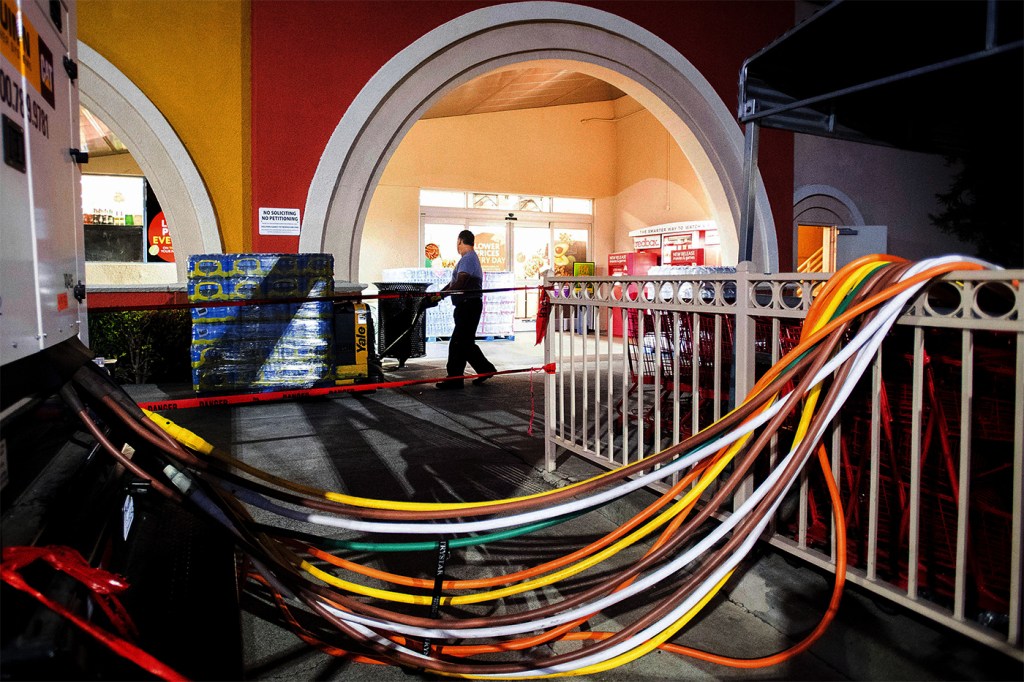What can the Pacific Gas and Electric blackouts over the California wildfire risk teach us about the future of power grids?

Less than a month after its last planned power outage, the energy company Pacific Gas and Electric has announced to 303,000 of its Northern California customers another potential shutoff, beginning Wednesday.
Wind, live electrical wires, and dry weather create a perfect storm for wildfires in a state that fires have already ravaged—some of which, including the Camp Fire of 2018, having been traced to PG&E equipment. Power shutoffs serve to prevent further damage.
But to prevent more long-term damage, the key may be the kinds of grids that don’t need shutting off: networks of community resources to lean on when others fail, and innovative energy systems that aren’t susceptible to such failures in the first place.
Current actions result in a harmful loop, says Daniel Aldrich, professor of political science, public policy, and urban affairs. “Man-made disasters” like power outages affect a wide swath of people but deal the heaviest blow to the same populations.
“This isn’t just an inconvenience,” says Aldrich, who is also the director of Northeastern’s master’s program in Security and Resilience Studies. “For the vulnerable and isolated, it can be a matter of life and death.”
And it is precisely being “isolated” that makes the “vulnerable” even more so. As Aldrich says, it’s not power outages alone that create risky circumstances, nor is it simply being elderly or in poor health. Rather, he says, it’s urban sprawl—the phenomenon of settling down beyond existing community resources and transportation systems—that permits both to be problems.
When people live far apart, as opposed to living in concentrated areas, resources are stretched thin, says Aldrich. This makes it difficult to carry out such prevention as clearing brush (an act that could prevent the fires that necessitate power shutoffs). It also means that the infrastructure that does reach these areas may not be regularly maintenanced.
But isolation also makes being elderly or sick a liability, as the scarcity of resources created by a power shutoff (e.g., lack of light for vision-impaired individuals, interrupted access to medical devices) cannot easily be mitigated by the actions of a neighbor, the way that a cup of sugar can be borrowed from someone who lives close by.
Even so, in its pre-shutoff statements, PG&E has urged customers to “[p]lan for medical needs like medications that require refrigeration or devices that need power” and “[k]eep in mind family members who are elderly, younger children and pets,” without any indication of how, exactly, to accomplish such tasks.
What Aldrich imagines, then, is effectively a replacement grid, one comprised of medical providers, shared devices, and places where people can receive such treatments as dialysis. “Rather than pushing individual mitigation—each one of us buying a generator—a smarter approach is to have a community-level set of safety nets,” Alrich says.
But what if people weren’t dependent on a grid at all?
Jennie C. Stephens, director of the School of Public Policy and Urban Affairs and the Dean’s Professor of Sustainability Science and Policy, says that these shutoffs emphasize the value of renewable energy owned by communities, eliminating the need for both electrical grids and the companies that oversee (and frequently neglect to control) them.
An alternate setup could be smaller-scale “microgrids” of solar panels, Stephens says, which can operate like islands, independent of the larger grid. These, in cases of both weather-related damage and planned shutdowns, could continue to operate.
Alternative energy systems could not only phase out the kinds of power grids that companies like PG&E maintain—they could also potentially mitigate the very weather events that make these power grids a liability in the first place.
“The transformation to more distributed renewable energy also reduces reliance on fossil fuels, ” Stephens says, ultimately reducing greenhouse gas emissions in quantities capable of then reducing climate risks, “including the fire-prone, dry, windy conditions” to blame for California’s susceptibility to wildfires.
“In the future, it’s much more likely that we’ll be facing more climate-induced events,” Aldrich says. However, given that prognosis, he says, the way California residents and officials respond now can light the way for how they, or others, will respond next.
“The disruptions in California are likely to accelerate the transformation to more distributed, locally controlled, renewable-based energy,” says Stephens, which Aldrich echoes. Whatever their course of action, “they will be the bellwether for what’s to come.”
For media inquiries, please contact Jessica Hair at j.hair@northeastern.edu or 617-373-5718.





